
Common pest form
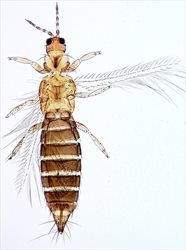
Dark form

Female - SEM image
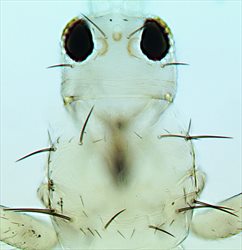
Head & pronotum

Antenna
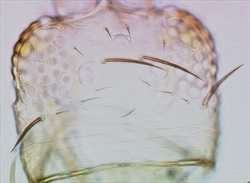
Head
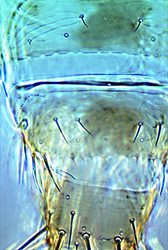
Tergites VII-IX

Tergites VII-VIII
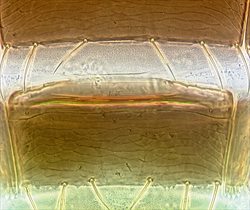
Female sternite VII
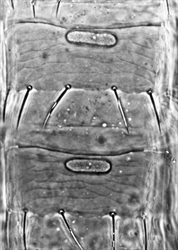
Male sternite pore plates

Fore wing
Both sexes fully winged. Body and legs variable in colour; a particularly common pest form is mainly yellow with a brown patch medially on each tergite, but among various populations body colour varies from almost uniformly dark brown to yellow; antennal segments III–V yellow but apices variably brown, more extensively brown in cooler climates; fore wing pale with dark setae. Antennae 8-segmented; segments III–IV with forked sense cone, VIII longer than VII. Head wider than long; three pairs of ocellar setae present, pair III longer than distance between external margins of hind ocelli, arising on anterior margins of triangle; postocular setae pair I present, pair IV longer than distance between hind ocelli. Pronotum with 5 pairs of major setae; anteromarginal setae slightly shorter than anteroangulars, 2 pairs of minor setae present between abteromarginal setae; one pair of minor setae present medially between posteromarginal submedian setae; upper surface of fore coxae without microtrichia on sculpture lines. Metanotum with 2 pairs of setae at anterior margin, campaniform sensilla usually present. Fore wing with 2 complete rows of veinal setae. Abdominal tergites V–VIII with paired ctenidia, these sometimes weakly developed on IV, on VIII anterolateral to spiracle; posteromarginal comb on VIII complete, with short slender microtrichia arising from triangular bases. Sternites III–VII without discal setae.
Male smaller and paler than female; tergite VIII with no posteromarginal comb; tergite IX posterolateral setae stout in larger males; sternites III–VII with transverse pore plate.
Similar to the Eurasian F. intonsa, this species from western North America has the postocular setae pair IV longer, and almost always has metanotal campaniform sensilla. Also remarkably similar in structure is F. panamensis, a species widely recorded by quarantine services around the world in shipments of live plants associated with the horticultural trade out of Colombia. It is usually darker than occidentalis, and both sexes have a series of microtrichia on the upper surface of the hind coxae (Gunawardana et al., 2017). Currently 230 species are listed in Frankliniella, with up to 130 further names placed into synonymy (Nakahara, 1997). These synonymies result from unrecognized variability in size and colour exhibited by many species. This variation is reflected in the large number of subspecies names listed under occidentalis. However, there are further problems with this species, in that Rugman-Jones et al. (2010) indicated that two species exist within some populations, but these can be distinguished only by the use of molecular data.
Adults have been taken from a very wide range of plants, feeding and breeding in flowers, on leaves, and often in buds. However, the species has also been reported as a predator on leaf mites under some conditions. Molecular data (Rugman-Jones et al., 2010) indicate that more than one genetic species exists under the name occidentalis, but nothing is known about any possible differences in biology or host-plant associations. Dark body colour is possibly related to low temperatures during development rather than to a genetic difference.
The Western Flower Thrips is an invasive pest species that was first recorded in Britain in 1986 (Baker et al., 1993; Kirk & Terry, 2003) and has subsequently established itself as the predominant thrips pest of horticulture and ornamental plant production under glass. It is also recorded from the Republic of Ireland (O'Connor, 2008). Although it is reported that F. occidentalis has overwintered outdoors at sites of commercial strawberry production (polytunnels in fields), the species has not been found in Britain in the wild independent of crop production. Originally from western North America, it is now widespread around the world, and is abundant in southern Europe.
THRIPIDAE - THRIPINAE
Frankliniella occidentalis (Pergande)
Euthrips occidentalis Pergande, 1895: 392
Euthrips tritici var. californicus Moulton, 1911: 16
Euthrips helianthi Moulton, 1911: 40
Frankliniella tritici var. moultoni Hood, 1914: 38
Frankliniella nubila Treherne, 1924: 84
Frankliniella tritici maculata Priesner, 1925: 15
Frankliniella claripennis Morgan, 1925: 142
Frankliniella canadensis Morgan, 1925: 143
Frankliniella trehernei Morgan, 1925: 144
Frankliniella occidentalis f. brunnescens Priesner, 1932: 182
Frankliniella occidentalis f. dubia Priesner, 1932: 182
Frankliniella venusta Moulton, 1936: 172
Frankliniella conspicua Moulton, 1936: 173
Frankliniella chrysanthemi Kurosawa, 1941: 173
Frankliniella dahliae Moulton, 1948: 97
Frankliniella dianthi Moulton, 1948: 98
Frankliniella syringae Moulton, 1948: 98
Frankliniella umbrosa Moulton, 1948: 105
Baker CRB, Barker I, Bartlett PW & Wright DM (1993) Western flower thrips, its introduction and spread in Europe and role as a vector of tomato spotted wilt virus. BCPC Monograph No 54: Plant Health and the Single Market, pp. 355–360.
Gunawardana DN, Li DM, Masumoto M, Mound LA, O’Donnell CA & Skarlinsky TL (2017) Resolving the confused identity of Frankliniella panamensis (Thysanoptera: Thripidae). Zootaxa 4323 (1): 125–131.
Kirk WDJ & Terry I (2004) The spread of the western flower thrips Frankliniella occidentalis (Pergande). Agricultural and Forest Entomology 5: 301–310.
Nakahara S (1997) Annotated list of the Frankliniella species of the world (Thysanoptera: Thripidae). Contributions on Entomology, International 2 (4): 355–389.
O’Connor JP (2008) A review of the Irish thrips (Thysanoptera). Irish Naturalists’ Journal 29: 20–24.
Rugman-Jones PF, Hoddle MS & Stouthamer R (2010) Nuclear-mitochondrial bar coding exposes the global pest western flower thrips (Thysanoptera: Thripidae) as two sympatric cryptic species in its native California. Journal of Economic Entomology 102: 877–886.